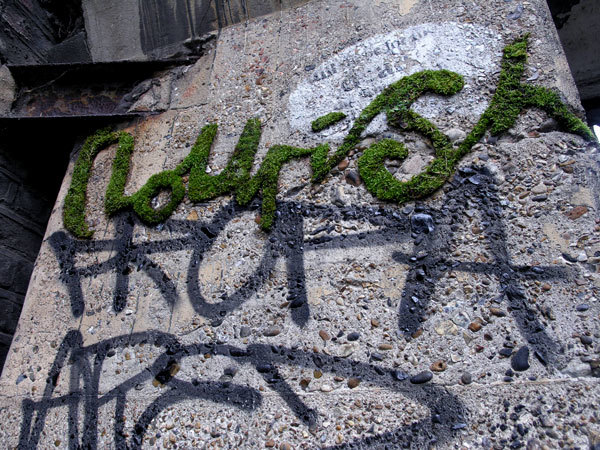- This topic has 1 reply, 12 voices, and was last updated 16 years, 1 month ago by
 Claudia Chalfa.
Claudia Chalfa.
-
AuthorPosts
-
February 1, 2009 at 9:31 pm #175407
 Ryan SandParticipant
Ryan SandParticipant
So before I go on with my thought on grafitti, I remembered this. Now it is not necessarily grafitti but when Andrew G mentioned message on message (which is a great and interesting point) I instantly went to this: http://www.yatzer.com/1321_new_trend_-_the_eco_graffiti It is a controlled environment so well just let this go.
Concerning urban grafitti vs urban art I thought it was interesting (something Kevin may have touched on) that a person would work on a piece that was so well developed in a place they new would get erased… you dont draw a masterpiece in the sand on the beach and dont expect it to get washed away (unless your Andy Goldsworthy haha).
I will also join the choir and say that situation is important. What seems to be consipired is that a public grafitti wall would just become a big community bullitin board, full of work/words that would destroy community instead of build it. If a designer didn’t want a wall for fear of “negative work” what makes them think they wouldn’t just tag a nearby building with the same problem? A neighborhood that becomes worse with a place for urban expression (designated grafitti walls) probably has plenty of other issues to deal with, such as law enforcement (gang violence was mentioned) and vandalism(the main reason why tagging on a designated wall was started). The hope of this wall was to channel vandalism while attempting to connect people with common interests such as art. Just as much as it could hurt it has just as much potential to help (my guess is the only way to find out is the try it … if it fails just knock it down, it is just a wall).
For such a progromatic element, Id think the important thing is to place it in an area that has a continual use, near the heart of activities/program. If possible apply a mixed use area with a set of program near the wall creating constant movement cycling of passerbyes, creating not only a constant surveillance but also enhancing interaction, visual entertainment, and cultural events…maybe these grafitti walls could become as popular to artists as muscle beach is to athletes (lame analogy I know zing!).
February 2, 2009 at 3:47 am #175406 Claudia ChalfaParticipant
Claudia ChalfaParticipantThanks Ryan. When you mentioned the “just tear it down if it doesn’t work” strategy, it made me realize that what also might work is temporary walls. You could try putting them in various places to see how different locations affect the content, etc. In fact, this would make a really great research project. I’m about to graduate, does anyone want to take this on?
February 2, 2009 at 4:50 pm #175405 Gil LopezParticipant
Gil LopezParticipantIt is interesting that Ryan S. brought the analogy that, “graffiti walls could become as popular to artists as muscle beach is to athletes” because last time I visited Venice Beach (2003) I saw their art walls being used precisely as this discussion is alluding to right next to the athletic rec areas. This is the 1st time I saw this type of wall and was impressed. I liked the fact that the tag artist where applying their art form such a public way.
While graffiti has its roots and still pushes a subversive, anti-establishment agenda, the art has grown and even matured in last 3 decades. As for the vandalized modern art in Belfast, I would argue that this is not actually graffiti any more than the nearby smashing of the glass installation is. The culprits where likely bored youth and obviously had little or no previous experience with aerosol spray paint. As the art has evolved from gang territory “tagging” and braggadocios name dropping or “bombing” to a form of higher artistic expression, tag artist have begun to respect one another’s work (as well as other artists) if it warrants it. This move away from the afore mentioned pissing contest has allowed the art to be more than stylized names and gang signs.
Although there are still immature, or possibly oppressed, or just bored people out there that deface great graffiti just like the modern art installment was defaced. Today great urban/street art often provokes social commentary on culture, politics and society itself. Other times it as a much needed form of artistic expression and causes others to just stop and break from the rush or life to reflect. The underground movement to graffiti art has changed a lot over the years and today these artists don’t employ only spray paint to craft their art. Much of today’s urban art is created with stickers, electronics or made of common “>urban materials. Often times they are meant to be temporary or designed to be defaced, call it viewer participation.I really like this topic and enjoy hearing others viewpoints, thank for posting it Claudia!
Regards,
Gil Lopez
Orlando, FLFebruary 2, 2009 at 7:00 pm #175404 Ryan SandParticipant
Ryan SandParticipantTemporary pieces taken to a performance level. This is one of my favorite videos I found awhile ago. It also takes the idea of tagging on top of something to a new level
http://www.youtube.com/watch?v=jtzdxseO-gsFebruary 3, 2009 at 12:22 am #175403 Daniel MillerParticipant
Daniel MillerParticipantI’ve found/seen “graffiti walls” to be an optimistically naive dream of designers and city officials attempting to relieve cherished walls, walkways and the such from the defamation of spray paint. There is a big between graffiti and vandalism, regardless of how brilliant (http://www.banksy.co.uk/outdoors/horizontal_1.htm) or how typically unsightly. Most graffiti falls more directly under the term vandalism, the the vandals don’t do it with respect to the space, the public or the owners.
We can implement all the graffiti walls we want, but unfortunately that’s not going set the parameters for what’s allowed to be tagged and what’s not. Graffiti is an expression of self, of identity and of art and tagging on a pre-determined “grafitti wall” goes against everything that its supposed to be about.
February 3, 2009 at 4:26 am #175402 Claudia ChalfaParticipant
Claudia ChalfaParticipantThanks for all the cool videos!! I really love those.
I agree that the defacement of existing public art is not graffiti. However, I do think it is worth an attempt, to give youth an arena for expression that is not illegal and yet still has a somewhat rebellious tone. The videos show me what I already suspected: these artists are all about process and presentation. The removal, destruction, replacement and renewal of their work is part of the process. The end goal is not to leave their mark so much as it is to make a performance of creating something ephemeral. This is similar, I think, to the idea of building sandcastles. The best part is watching it melt back into the sea. I also think these artists probably enjoy having others watch them create the work – that’s why all those films are on youtube.
I wonder if the idea of providing this venue is really “naively optimistic”? I bet that it works in some cases and not others. I also think its worth a try in areas where there are a lot of bored young people hanging around looking for something to do. (What town in this country can you name that doesn’t have that?) If it doesn’t work, okay, move on to the next idea. But it doesn’t seem like a very expensive or difficult idea to try.
February 3, 2009 at 5:33 am #175401 Ryan SandParticipant
Ryan SandParticipanti playfully reply “stubbornly pesimistic”,
That aside, someone mentioned the article for grafitti in the LAM from Feb. Id also like to bring up the article from January, about the Mies Van der Roe plaza and the disruptive skaters. Skaters still occupied the area and directed their attention even when the landlord cut up the stone benches. Now one would say that I am using an example against my argument, “even though they tried to prevent vandalism the kids still skated”. But this isn’t about the protection of the landscape but giving kids an outlet. Suggesting the putting of culture (paint in this case) in a kids hand instead of a gameboy…
February 3, 2009 at 7:05 am #175400 Rami BadawiParticipant
Rami BadawiParticipantWell i think graffiti is artistic, but as Andrew said (somehow) i find that if its well manipulated it can give a great impact and be an artistic intervention specially not overlaying another artists work.
I used graffity in my FYP you can check it out on my page, i designed a wall only for graffiti in front of a skate park, and i did that because graffiti was all over the city i worked on. I found out that by designing a space, a wall for this kind of intervention makes it more valuable and improves it esthetically. Gangs or whatever, people should get the chance to express themselves and graffiti nowadays has become a nice way to do it… just give em spaceFebruary 3, 2009 at 7:07 am #175399 Rami BadawiParticipant
Rami BadawiParticipanthehe i agree
February 3, 2009 at 1:17 pm #175398 Claudia ChalfaParticipant
Claudia ChalfaParticipantExactly my thought, Ryan. As for the skaters, what if they gave them a skate park? Don’t even get me started on the issue of teenagers and the severe lack of design geared towards them. The kids are going to skate. the kids are going to paint. So, why not give them places where they can do this without destroying things?
February 3, 2009 at 4:15 pm #175397 Gil LopezParticipant
Gil LopezParticipantI don’t see the harm in giving the kids an outlet whether its a legal wall for tagging up, a skatepark or sports fields. Just because many of us didn’t grow up with these “nontraditional” passtimes doesn’t mean they should be repressed or looked down upon. Soon we are going to have to figure out a way to design cityscapes that are good for parkour too. These are things that kids want to do and they should be encouraged, who wants to repress the physical activity and artistic creativity of the youth?! Rami broached the idea that legal walls can make graffiti, “more valuable and improves it esthetically.” I live in Orlando and there is a hotline and website set up for graffiti removal but the official policy is that, “[Orlando] respects and supports creative expression – not vandalism!” This would lead one to believe that creative, artful graffiti would be tolerated in some situations. So the problem is, if there are no walls to practice and refine the skills required to create a masterpiece with aeresol spray paint, all the “practice” and early works are going to be viewed as blatant vandalizm. I know its a bit of a stretch but, just imagine if the old folks of yore thought that football or basketball was a waste of time and refused to provide valuable space in the built environment for these activities. The NFL and NBA would be in a sad place right now not to mention college ball.
February 3, 2009 at 5:48 pm #175396 Ahmed AlomaryParticipant
Ahmed AlomaryParticipantHi Claudia,
for peoples in Iraq its not vandalism , the true criminals those who put walls in cities ??????????
http://www.thenational.ae/article/20081205/FOREIGN/815173379/1002
http://www.latimes.com/news/nationworld/world/la-fg-walls29-2008oct29,0,3095275.story
http://www.usatoday.com/news/world/iraq/2007-04-26-baghdad-art_N.htm
RegardsFebruary 3, 2009 at 7:47 pm #175395 Claudia ChalfaParticipant
Claudia ChalfaParticipantHi Ahmed, thanks for posting that. I am always glad to see people reacting to war and violence in positive ways: you may be interested in reading “Defiant Gardens: making gardens in wartime” by Kenneth Helphand, as well. If you are in Iraq or know anyone who is, please ask them to document some of these images because as the article mentions, they may not be around forever so it would be nice to preserve their memory.
February 3, 2009 at 7:49 pm #175394 Claudia ChalfaParticipant
Claudia ChalfaParticipantThanks Gil, I agree with you. I like your point about giving kids a chance to fine-tune their skills, too.
February 3, 2009 at 8:43 pm #175393Nicholas Thayer
ParticipantGreetings All,
As has been said, great topic.
Specifically to Claudia’s starting point, “and am also curious as to whether graffiti walls work or not.” My thought is not the following discussion, which has been informed and spirited, but the starting question. The examples shown are not graffiti but murals, whether sanctioned or not. There is then the distinction between graffiti and tagging.
So this discussion seems more about outsider art finding a way to express itself versus a “violent” expression (i.e. tagging) when no other outlets are available. I am thinking specifically about Einstein’s quote about violence being the last resort of the dispossessed. Youth in this case.
As an aside, I am puzzled and amused by the tone used when speaking about “youth”. Like they are some kind of alien species that no one can figure out. “Skaters from Neptune sent to destroy the fabric of society!” Another topic perhaps?
Cheers! -
AuthorPosts
- You must be logged in to reply to this topic.



